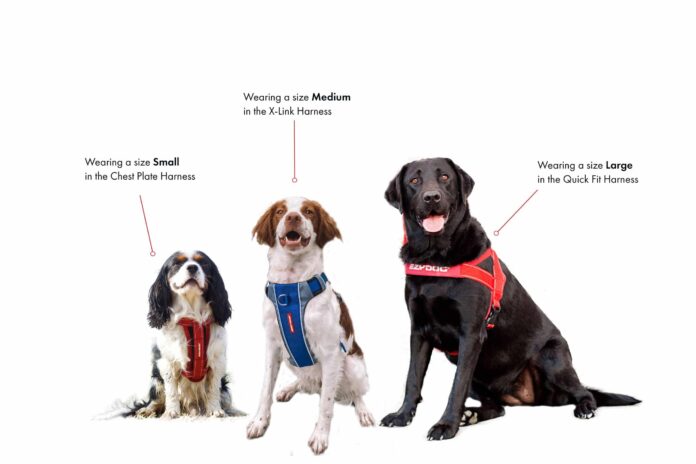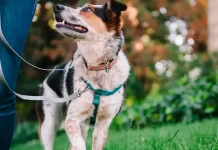Are you a dog owner who’s struggling to find the perfect harness for your furry friend? Well, look no further!
In this article, we’ll guide you through the process of determining the right size harness for your dog, ensuring their comfort and safety during walks and outdoor adventures. Because let’s face it, nothing is worse than a too-tight or too-loose harness that leaves your pup feeling uncomfortable or at risk of escaping.
So, whether you have a tiny Chihuahua or a majestic Great Dane, we’ve got you covered with our simple and practical tips for finding the perfect fit. Say goodbye to guesswork and hello to a well-fitted harness, allowing your pup to strut their stuff in style!
Choosing the right size harness for your beloved canine companion is essential for their comfort, safety, and overall well-being. With so many factors to consider, it can sometimes feel overwhelming. But fear not! We’re here to guide you through the process and help you determine the perfect fit for your furry friend.
Factors to Consider
When it comes to selecting the right harness size, there are several key factors to take into account:
Measurements
Before diving into the world of harnesses, it’s important to measure your dog accurately. There are a few key areas to focus on:
Neck Girth
Wrap a soft tape measure around the base of your dog’s neck, where their collar usually sits. Make sure to allow for a comfortable fit, without constricting their breathing or movement.
Chest Girth
Measure the girth of your dog’s chest, just behind their front legs, at the widest part. Again, you want to ensure a secure fit without restricting their breathing or movement.
Back Length
Measure the distance from the base of your dog’s neck to the base of their tail. This measurement will help you determine the appropriate length of the harness.
Weight
Knowing your dog’s weight is crucial for selecting the right size harness. Manufacturers often provide weight ranges for each size, so having an accurate weight measurement is essential.
Age
Puppies and adult dogs have different body proportions, so it’s important to consider your dog’s age when selecting a harness size.
Growth Potential
If you have a puppy with a lot of growing to do, it’s essential to choose a harness that can be adjusted as they grow. This will save you from having to buy multiple harnesses as your furry friend continues to develop.
Guidelines for Sizing
Now that you have your dog’s measurements, it’s time to dive into the world of sizing guidelines. Here are a few tips to help you make the right choice:
Size Charts
Many manufacturers provide size charts that correlate measurements to specific harness sizes. These charts can serve as a helpful starting point in your search for the perfect fit. Take note of whether the measurements align with your dog’s specific proportions.
Manufacturer Recommendations
Different manufacturers may have their own unique sizing systems. It’s always a good idea to check the specific recommendations provided by the brand you’re interested in. They may have additional tips or adjustments to consider.
Adjustability
Harnesses with multiple points of adjustment can be particularly useful, especially if your dog is still growing. This way, you can fine-tune the fit as they develop, preventing the need to purchase a new harness every few months.
Fit Testing
Once you’ve selected a size, it’s crucial to perform a fit test. This involves putting the harness on your dog and ensuring it fits snugly but comfortably. Check for any areas that may be too tight or too loose, and make any necessary adjustments.
Different Types of Harnesses
Not all harnesses are created equal! There are various types available, each with its own unique features and benefits. Here are a few popular options:
Back-clip Harness
Back-clip harnesses have a D-ring located on the back, opposite the chest area. This design is a popular choice for dogs who tend to pull on walks. The back-clip style provides better control and reduces strain on the neck.
Front-clip Harness
Front-clip harnesses have a D-ring located on the chest area. This design encourages dogs to walk by your side rather than pulling forward. It’s a great option for dogs in training or those who are easily excitable.
Step-in Harness
As the name suggests, step-in harnesses are designed for dogs to step into. They wrap around the chest and have a buckle or clasp on the back. This style is often preferred by dogs who are not fans of having things put over their heads.
Vest Harness
Vest harnesses are known for their extra coverage and support. They distribute pressure evenly across the chest and back, making them a comfortable choice for dogs with sensitive necks or backs.
Head Halter Harness
Head halter harnesses resemble horse halters and are designed to gently guide your dog’s head. This style provides excellent control and is often recommended for dogs who are reactive or strong pullers.
Common Sizing Terms
When browsing for harnesses, you’ll often come across sizing terms such as Extra Small (XS), Small (S), Medium (M), Large (L), and Extra Large (XL). These terms are used to categorize different harness sizes based on measurements.
Extra Small (XS)
Extra Small harnesses are typically designed for toy or very small breeds, such as Chihuahuas, Yorkshire Terriers, or Toy Poodles.
Small (S)
Small harnesses are suitable for small breed dogs like Dachshunds, Shih Tzus, or Pugs.
Medium (M)
Medium harnesses generally fit medium-sized breeds like Beagles, Border Collies, or Cocker Spaniels.
Large (L)
Large harnesses accommodate larger breeds such as Labradors, Golden Retrievers, or Boxers.
Extra Large (XL)
Extra Large harnesses are designed for giant breeds like Great Danes, Mastiffs, or Saint Bernards.
Measuring Tips
To ensure accurate measurements, here are a few handy tips to keep in mind:
Use a Soft Tape Measure
Using a soft, flexible tape measure will help provide more precise measurements. Avoid using a rigid ruler or anything that could cause discomfort to your dog.
Ask for Assistance
If possible, have another person assist you during the measuring process. This will make it easier to keep your dog still and ensure accurate measurements.
Measure at the Widest Points
When measuring your dog’s neck, chest, and back length, always take the measurements at their widest points. This will help ensure a comfortable fit without any restrictions.
Account for Coat Thickness
If your dog has a long or thick coat, take that into consideration when selecting a harness size. You may need to adjust the measurements to account for the extra fluff.
Considering Breed Characteristics
Different breeds may have specific body proportions that can impact their harness fit. Here are a few breed categories to consider:
Toy and Small Breeds
Toy and small breed dogs often have delicate necks and chests. It’s important to choose a harness that provides adequate support and doesn’t put unnecessary pressure on these areas.
Medium and Large Breeds
Medium and large breeds vary greatly in size and body shape. It’s crucial to find a harness that can accommodate their unique proportions, offering both comfort and control.
Giant Breeds
Giant breeds require harnesses designed specifically for their massive size. These breeds often have wider chests and necks, so it’s essential to select a harness that can handle their dimensions safely.
Mixed Breeds
Mixed breed dogs come in all shapes and sizes, making it challenging to rely solely on breed-specific recommendations. Take measurements and breed characteristics into consideration to find the right harness size for your unique furry friend.
Importance of Proper Fit
Why is it so crucial to choose the right size harness? Well, there are several important reasons:
Safety
A properly fitting harness ensures that your dog is secure and protected during walks and other activities. A loose or ill-fitting harness can easily slip off, putting your furry friend at risk of escaping or getting injured.
Comfort
Just like humans, dogs value comfort. A well-fitting harness allows for natural movement and prevents rubbing or chafing. Your dog should be able to walk and play without feeling restricted or uncomfortable.
Preventing Escapes
If a harness is too loose, your dog may be able to wiggle their way out of it. This can lead to dangerous situations, especially if your dog has a tendency to run off or chase after squirrels.
Preventing Choking
A harness that is too tight can constrict your dog’s breathing or cause discomfort. It’s essential to find the right balance between a secure fit and allowing your dog to breathe and move freely.
Seeking Professional Advice
If you’re still unsure about which harness size is best for your dog, don’t hesitate to seek professional advice. Here are a few options to consider:
Consulting a Veterinarian
Your veterinarian is a valuable resource when it comes to selecting the right harness size. They can offer guidance based on your dog’s specific needs and help address any concerns you may have.
Visiting a Pet Store
Many pet stores have knowledgeable staff members who can assist you in finding the right harness size. They can provide recommendations based on your dog’s breed, size, and measurements.
Contacting a Dog Trainer
Dog trainers often have experience with various harnesses and can offer valuable insights into finding the perfect fit for your pup. They can provide guidance on which style of harness may be most suitable for your dog’s training needs.
Reevaluating Size as Your Dog Grows
Remember, your dog’s size and proportions can change, especially during their puppy growth phases. It’s important to reevaluate and adjust their harness size accordingly.
Puppy Growth Phases
Puppies go through rapid growth phases, and what may have fit perfectly one month may be too small the next. Regular measurement updates and harness adjustments are essential to keep up with their expanding bodies.
Regular Measurements
Even for adult dogs, it’s a good idea to periodically measure their neck girth, chest girth, and back length to ensure their harness still fits correctly. This is especially important if your dog has gained or lost weight.
Harness Adjustability
Choosing a harness with adjustable straps and buckles allows for easy size adjustments as your dog grows. This can save you the hassle of purchasing multiple harnesses throughout their life.
In conclusion, selecting the right size harness for your dog requires careful consideration of measurements, breed characteristics, and personal preferences. Taking the time to measure your furry friend accurately, consulting size charts, and seeking professional advice will ensure a snug and comfortable fit. Remember, a properly fitting harness is essential for your dog’s safety, comfort, and overall enjoyment during walks and other activities. Happy sizing, and enjoy many adventures with your four-legged companion!









































